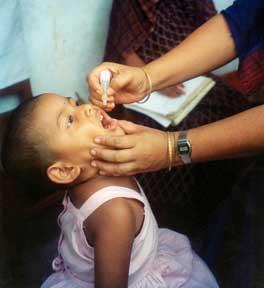New Vaccine May Finally Rid World Of Polio

Share
Researchers in India and Switzerland have found that a relatively new vaccine may hold the key to eradicating Polio from the face of the Earth. Bivalent oral poliovirus vaccine (bOPV) not only performs as well as traditional vaccines, it does so against a wider range of virus types. It may allow children in Polio hotspots to develop resistance to more strains of the virus quicker, cutting down on infections, and stopping pandemics from growing. According to Reuters, 55 million children in Africa will receive bOPV starting this week, and the vaccine is already in wide use in Afghanistan. Thank goodness because Polio is a nasty little bug. One in two hundred infected will develop paralysis and between 5-10% of those will die from inability to breathe. For much of the world, the threat of Polio is only a frightening bit of history, but as long as any child has the disease, the risk of global infection remains. bOPV not only gives hope for the eradication of Polio, but may serve as a model for eliminating other viruses from our world as well.
Since 1988, the prevalence of Polio has been curtailed dramatically. According to the World Health Organization we've gone from around 350,000 cases in '88 to less than 2000 cases reported in 2006. However, just because Polio has been on the decline in the past decades doesn't mean it is gone. In fact, between 2003 and 2005, 25 countries that were previously Polio free were reinfected. In the modern age of high speed travel the only true protection a nation has against a Polio pandemic spreading to their borders is eliminating the disease from the Earth entirely.
To that end, bOPV is a godsend. It's oral, allowing for easier, faster dosing, and it provides great resistance to two strains of the virus (type 1 and type 3). As discussed in the Lancet, researchers in India, with guidance from Roland Sutter (Switzerland) from the WHO, compared bOPV to triple and single strain versions of polio vaccines. bOPV clearly outperformed the triple vaccine, and came very close to matching the single strain vaccines. In other words, bOPV isn't the absolute best, but it hits two strains at once while still being very effective. That means it could be the perfect tool for immunizations in remote locations.
Be Part of the Future
Sign up to receive top stories about groundbreaking technologies and visionary thinkers from SingularityHub.


Which is exactly what's happening. The four countries in the world with major Polio problems are Afghanistan, Nigeria, Pakistan, and India. bOPV has been in wide use in Afghanistan since late last year, and is working it's way through northern India now. bOPV is generated by GSK in Britain and Panacea Biotec in India, the latter of which helped fund the Lancet study. According to comments about that study in the Lancet, cases in India have dropped from 260 in 2009 to just 32 in 2010. The 55 million children slated to receive bOPV in Africa will hopefully reduce rates there as well. According to Reuters, however, that funding for 2010-2012 vaccinations is only at 50% of what it needs to be.
Clearly the fight against Polio isn't over. If the world focuses on it now, while the problem is shrinking, we could consign the disease to history. If we grow lackluster in our efforts because we think the virus is less threatening now than before, we open ourselves to reinfection and increased global danger. I am reminded of a game of Risk, where a pesky opponent has retreated to Australia and bunkered down for a long siege (apologies to the Aussies, but their nation is probably the most infuriating place in the world in that game for this reason alone). We just need to push a little harder and we can knock Polio off the map. Until we do, we're still at war.
As critical as this situation may be, I hope that it is one that we will face repeatedly in the future...only for different viruses. Let's eradicate Polio now, and then work to do the same for other contagious diseases. Polio, with its global history of destruction, is a great place for us to gather worldwide support and momentum. Kill Polio, then move on to the rest. Vaccines may not always be the solution, either. We've discussed how other virus treatments, based on protein disruption, could also work to treat and reduce infection. It doesn't matter what tool we use, we just need to have complete victory as often as possible. Not every pathogen can be destroyed in this way, flus and colds will probably always be with us, but some of the worst can be. A future with fewer deadly epidemics is possible, we just need to fight for it.
[image credit: WikiCommons]
[sources: Sutter et al 2010 Lancet, WHO, Reuters]
Related Articles

Single Injection Transforms the Immune System Into a Cancer-Killing Machine

This Light-Powered AI Chip Is 100x Faster Than a Top Nvidia GPU

This Week’s Awesome Tech Stories From Around the Web (Through December 20)
What we’re reading
